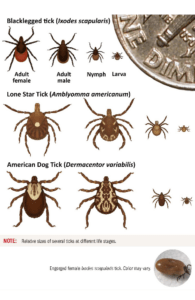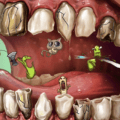Red Meat Allergies Caused by Ticks: An Emerging Public Health Concern

Red meat allergies are becoming increasingly common in the United States. The most common cause of red meat allergies is a tick bite from the lone star tick. The lone star tick is found in the southeastern and south-central United States, and it is becoming more common in other parts of the country.

What is Alpha-gal?
Alpha-gal is a sugar molecule that is found in red meat, dairy products, and some other foods. When a person is bitten by a lone star tick, the tick can transmit the alpha-gal molecule to the person’s bloodstream. The person’s immune system then sees the alpha-gal molecule as a foreign invader and produces antibodies against it.

Symptoms of a Red Meat Allergy
The symptoms of a red meat allergy can vary from person to person. Some people may experience mild symptoms, such as hives or itching. Others may experience more severe symptoms, such as anaphylaxis. Anaphylaxis is a life-threatening allergic reaction that can cause difficulty breathing, swelling of the throat, and a drop in blood pressure.
The symptoms of alpha-gal syndrome can range from mild to severe and can occur within minutes to hours of eating red meat. Common symptoms include hives, itching, nausea, vomiting, diarrhea, and difficulty breathing. In some cases, the reaction can be life-threatening.
Cause
The lone star tick carries the bacterium Amblyomma americanum, which produces the sugar molecule alpha-gal. When bitten by a lone star tick, a person can develop an allergy to alpha-gal. This is because the body’s immune system mistakenly identifies alpha-gal as a harmful substance and produces antibodies against it.
Diagnosis
Alpha-gal syndrome can be difficult to diagnose as the symptoms can be similar to those of other allergic reactions. However, there are a number of tests that can be used to confirm the diagnosis.
Treatment
There is no cure for alpha-gal syndrome, but there are treatments that can help manage the symptoms. These include antihistamines, epinephrine, and avoiding red meat.
Diagnosing a Red Meat Allergy
There is no single test that can definitively diagnose a red meat allergy. However, doctors can use a combination of tests to make a diagnosis. These tests may include:
- A skin test: This test involves injecting a small amount of alpha-gal into the skin. If the person has a red meat allergy, they will develop a rash at the injection site.
- A blood test: This test measures the levels of antibodies to alpha-gal in the blood.
- A food challenge: This test involves giving the person a small amount of red meat to see if they have an allergic reaction.
Treatment for the Red Meat Allergy
There is no cure for a red meat allergy. However, there are treatments that can help manage the symptoms. These treatments may include:
- Avoiding red meat and other foods that contain alpha-gal
- Carrying an epinephrine auto-injector in case of anaphylaxis.
- Taking antihistamines to relieve mild symptoms
Preventing Red Meat allergies
The best way to avoid a red meat allergy is to avoid being bitten by ticks. This can be done by wearing long sleeves and pants when you are in tick-infested areas, using insect repellent, and checking yourself for ticks after you have been outdoors.
Emerging Public Health Concern
The CDC has warned that alpha-gal syndrome is an “emerging public health concern.” The number of cases of alpha-gal syndrome has been increasing in recent years, and it is now being reported in all parts of the United States. The CDC believes that the increase in cases is due to the expanding range of the lone star tick.
Conclusion
Red meat allergies caused by ticks are an emerging public health concern. The number of people with these allergies is increasing, and there is no cure. However, there are treatments that can help manage the symptoms. If you think you may have a red meat allergy, it is important to see a doctor to get a diagnosis and treatment plan.






